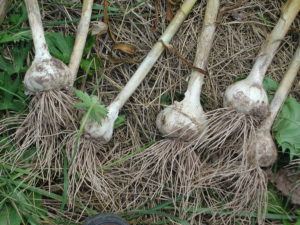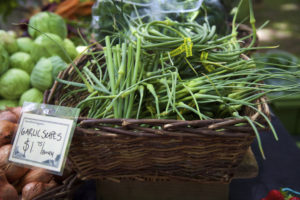By Emily Sides
Garlic is a great low-maintenance cash crop. Brian Fox planted 35 pounds of garlic in his garden 11 years ago. He now plants 700 pounds every October using 15 tons of hay mulch at Salem Mountain Farms in northeastern Pennsylvania. He harvests about 4,000 pounds the next summer. “I can’t imagine stopping,” he said. “It’s certainly a satisfying thing to grow. It’s one of those things we see in the spring before actual leaves start growing on trees.”

He is not super busy when garlic needs attention. He hand-pulls it after his busy planting season in June and early July.
“It’s a natural fit with the things we do on the farm,” he said. “We isolate it from everything else.”
Fox started with a mentor and has since been able to pass along his knowledge. He presented a workshop to more than 40 farmers entitled “Growing Great Garlic: Three Years to a Low-Maintenance Cash Crop” at a Pennsylvania Association for Sustainable Agriculture (PASA) field day.
“Eight or 10 were people I knew who just wanted to see how I did things,” he said. “Others were looking for something to grow or had been growing garlic on a small scale.”
Growing Garlic
A five- to seven-year rotation prevents fungus or disease build-up. Garlic thrives in loose soil with a pH of around 6.5. He grows German White, a hardneck variety also referred to as German Extra-Hardy or German Red. This variety grows well in heavier soil and thrives in the Northeast.

Hardneck varieties do well in cold areas and keep longer than softneck. Softneck varieties, which are smaller on average, fare well in a wide range of climates, even enduring irregular weather, but grow better where winters are moderate. Producers should ask local farmers which varieties they have had the most success with in their climate.
In his second year, Fox’s biggest mistake was planting in a wet area where the garlic was sitting in water in the winter. “Start small,” Fox said. “Learn your mistakes before you are too big. You have to grow into it.”
Now he makes raised beds each year to protect plants from heavy water. Using a modified potato hiller, he makes the beds six to eight inches tall. He plants cloves with the pointed end up about half an inch or an inch into the soil. This method helps the ground stay frozen in the spring so it will not expand and contract, potentially working the clove right out of the ground.
The hay mulch he spreads helps roots grow in the fall. This layer of insulation also leaves a tremendous amount of compost and significantly deters weeds from springing up. During the worst years he has spent two hours weeding the entire season.
Harvesting Garlic
Before harvesting, scapes can be snapped off at the curl and sold, allowing the plant to put more energy into the bulb. Scapes are gaining market momentum for their spicy green garlic flavor.
Garlic is ready to harvest when there are four or five brown leaves. Since garlic bruises easily, leaving it vulnerable, Fox gently knocks off dirt and then lays the plants in bunches in a barn or, better yet, in hay wagons or a truck bed. That way he can easily pull the garlic out to let it dry in the sun for a few days — just not in scorching heat.
Garlic should be dried for four to six weeks. Fox dries it until the stem can snap. If garlic is not properly dried, mold or rotting can occur. There is a small chance of developing blue/gray mold and fusarium during the drying process.
After drying, garlic can be stored without refrigeration for at least six months.
“You don’t have cold storage for two tons of carrots,” Fox said. “But we can easily keep 3,000 pounds of garlic in our barn, sell most of it before October, and have a few hundred pounds to sell through the winter.”
Producers can sort by size in a barn, garage, basement, or any well-insulated room. Fans help maintain a good airflow. If 50 degrees or cooler is not achieved, an air conditioner may be used. Garlic should not freeze. Adding light can raise the temperature.
Scaling Up Production
Here is Fox’s breakdown of how to scale up to planting 300 pounds by the third growing season. His price estimates will vary based on location and availability.
To plant 20 pounds, growers will need to invest $400, which includes $200 for seed ($10 per pound), $80 for compost, $50 for hay, $60 for lime, and $5 for summer cover crop seed.
While some suppliers sell seed for more than $20 per pound, Fox said independent growers sometimes offer lower prices.
The 1:5 seed-to-harvest ratio means that 20 pounds will on average yield 100, although some varieties may produce even more.
Fox recommends saving seeds. From the 100-pound harvest, growers should replant 80 pounds. That will yield 400 pounds in the second year.
“Plant the largest, nicest garlic back in the ground,” he said. “Even if you want to eat or sell it, it’s better to plant it.”
The second season will cost $780 to plant the saved 80 pounds. This includes $320 for compost, $200 for hay, $240 for lime and other soil amendments, and $20 for cover crop seed.
Of the second season’s harvest (400 pounds), growers can eat or sell 100 pounds. Garlic prices can range from $6-$10 a pound. Garlic has a steady market, according to a report published in November 2012 by the USDA Agriculture Marketing service.
If producers keep 20 of the 100 pounds from the second season’s harvest for themselves, they can sell 80 at around $7 per pound to earn $560.
Growers will need $1,290 to plant the 300 saved pounds in the third season: $600 for compost, $300 for hay mulch, $340 for lime and other soil amendments, and $50 for cover crop seed.
The third season — from which larger profits can be achieved on a half-acre — will yield 1,500 pounds of garlic.
If growers sell 1,000 pounds, they could expect to earn anywhere from $6,000 (at $6/lb) to $9,000 (at $9/lb).
The 500 pounds of saved seed — if growers want to expand in the fourth season — will yield 2,500 pounds. Setting aside 500 pounds for the fifth season, growers can sell 2,000 pounds for $14,000 (at $7/lb).
Garlic Pests
Since he knows how to grow his two varieties well, Fox does not want to risk getting garlic bloat nematodes, garlic’s biggest foe, or other diseases by adding a new variety of seed. Garlic must be tested for nematodes since nematode symptoms are similar to other less harmful diseases.
“It’s very dangerous,” Ed Fraser said. “People have gone out of business. Farms with 50 acres have closed their doors because of nematodes.”
Fraser, who has been growing garlic for 19 years, sells organic garlic seed to about 600 people every year in New York.
He has been testing for nematodes at Cornell University’s Cooperative Extension since the infestation started four years ago.
They are hoping to find a natural way to get rid of the pest. Crystal Stewart, vegetable specialist for Cornell’s program, said that nematode numbers have decreased in tested garlic and also in the field.
“Growers should carefully monitor their new garlic plants,” she said. “If they see any suspicious-looking plants they can submit them for testing.”
Selling for the Table or for Seed?
In his third year, Fraser was selling garlic as seed and to stores. He considers table stock to be less than 2 inches in diameter.
He said seed can be as expensive as $12 a pound. Larger bulbs, which are more expensive per pound, are better for planting.
“But then I looked at the price I was getting from the grocery store compared to seed stock and wondered if maybe I ought to grow primarily seed stock,” he said. “It seemed to be worth a lot more money that way.”
In early June 2012, he sold 1,200 pounds of scapes, which he said last about three months when refrigerated.

He said they can sell for $3-5 a pound. He cuts the roots, which can be four feet deep, with a steel blade in early July. This unfortunately prevents him from using mulch, though, because it would clog the blade.
“Mulching will give you a better product generally,” he said. “It also keeps the soil a bit warmer so garlic can set roots from October through January. I get around it by making a little line where I plant the garlic and then coming back and putting a mountain of dirt on it.”
The dirt mountain is mashed down by the rain and thaw of snow over winter.
“Garlic is very sturdy,” he said. “It will push itself through a lot of material, so don’t worry about it.”
Fraser advises farmers to investigate growing garlic, depending on their schedule.
“If you’re a grain farmer, it’s doable but it might be more taxing on your whole farm because of the different timeframe,” he said. “Vegetable farms who are already growing 30 other vegetables should definitely add garlic.”
This article appeared in the September 2013 issue of Acres U.S.A.

